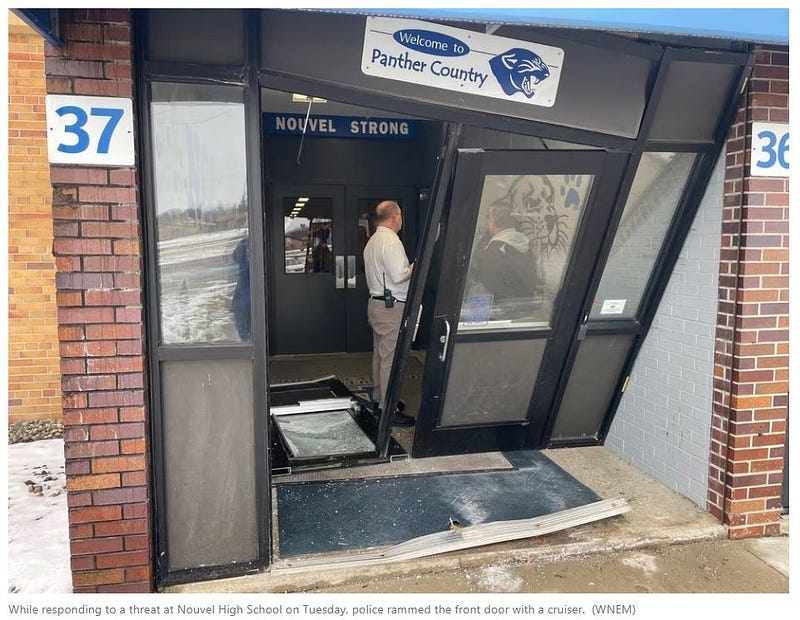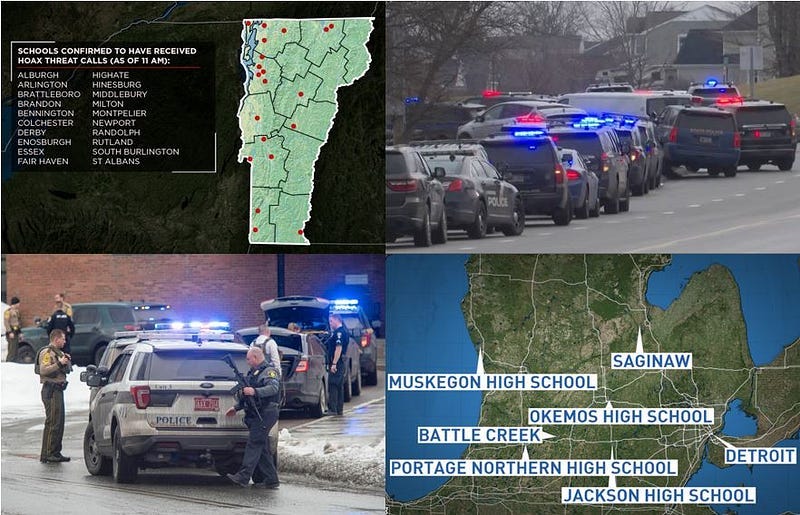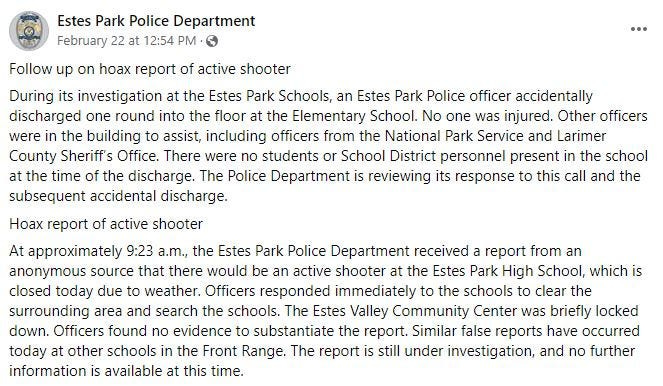Swatting Schools: Serial hoaxes causing real dangers
On Tuesday February 7, 2023, a call came in for a school shooting in progress at Nouvel High School in Saginaw, Michigan. Officers raced to…
On Tuesday February 7, 2023, a call came in for a school shooting in progress at Nouvel High School in Saginaw, Michigan. Officers raced to the campus to find the front doors locked. Fresh from the memories of gross inaction at Robb Elementary in Uvalde, officers quickly decided to ram their patrol car through the front doors of the school to break through and stop whatever was happening inside.
But there was no shooter inside — just shocked students and staff who were horrified to see a police car ram its way inside the building. The 911 call was yet another “SWATting” hoax that is part of a troubling national trend of falsely reporting a school shooting to cause a huge police response.

So far this week in Vermont, Michigan, California, and Florida, more than 30 simultaneous, coordinated swatting calls have falsely reported a school shooting. In Vermont, more than 20 schools received simultaneous hoax threats that created chaos and confusion as police and parents raced to schools, while terrified students locked down inside their classrooms. Hundreds of swatting hoaxes have happened in at least 30 states since fall 2022 and are part of a coordinated plot that targets 20 or more schools in the same state, at the same time. Why is this happening? Nobody knows for sure. The best theory is that the person or group making these hoaxes wants to cause a massive police response to each one.
Nationwide Pattern
These calls are all connected because they have the same profile and sometimes the exact same message. Each 911 call is a looped recording played with an auto-dialer. The caller states over and over that he is inside a school and people have been shot. A very important detail is the caller does not interact with the 911 operator or answer any questions because this is a recording and not a real person.
What is Swatting?
False 911 calls to force a panic and a police response at a venue date back to the 1970s. In most swatting scenarios, someone makes an elaborate report–hostage situations or multiple people shot–to trigger the highest priority police response. In 2015, swatting during live streamed video game competitions got mainstream attention. The calls are usually placed through voice-over-internet phone services and with a VPN that renders them nearly impossible to trace. A further complication for schools is that anonymous reporting apps have been mandated in many states which gives students an easy way to make a false report without getting caught.
Bogus Call, Real Dangers
Anytime officers respond code 3 (lights and sirens) for a shooting in progress at a school, there is a high level of danger. This week, teachers in Michigan described officers with guns drawn searching their classrooms as students hid under desks. When 911 gets the call and urgently dispatches police, people at the school have no idea there was even a threat made.
A school shooting is an “all hands” response — meaning that every officer in the area, even those who are off duty, get an urgent alert. This situation can cause the following problems:
police involved traffic accident responding
parents involved in traffic accident trying to get to the school
confrontation between police and parents (post-Uvalde tension)
blue-on-blue shooting with a plainclothes officer or armed security
accidental discharge by officer running with a weapon
armed teacher or parent shooting someone during the confusion
student or teacher injuries barricading classrooms or jumping out of windows
These are real risks. A Florida officer shot himself in the leg inside a school during a response to a false report of a shooting the day after Parkland in 2018. During the response to the Colorado STEM school shooting in 2019, a school security officer shot at a police officer and missed, hitting a student instead.
With these costly and frightening hoax incidents numbering in the hundreds, there is a dire need for better situational awareness to deescalate these situations before someone is seriously injured or killed.
What we can do:
1) Intel bulletin from the FBI or Department of Homeland Security to local 911 centers with guidance about how to recognize this hoax.
2) When there is a call that sounds like a hoax, in addition to dispatching initial officers to investigate, a supervisor should call the school, find out if there is an attack taking place (or nobody answers the phone), but if everything is normal at the school, the police response can be scaled back. When there isn’t a shooting going on at the school, officers don’t need to drive through the front door!
3) When the first officer arrives at the school and there is no school shooting taking place, that officer needs to cancel everyone else.
These checks happen every single day across the country when fire departments respond to 911 calls for fires that turn out to be false alarms.
There is an established pattern and profile from the same type of hoax in more than 30 states since September. Each instance that generates +100 officers responding to these hoaxes is perpetuating the cycle.
We don’t have the power to stop someone in a foreign country from making 911 calls over the internet. We do have the power to decide how we respond to them.
David Riedman is the creator of the K-12 School Shooting Database and an internationally recognized expert. Listen to my recent interviews on Freakonomics Radio, New England Journal of Medicine, and Wisconsin Public Radio after the Mount Horeb Middle school shooting.








